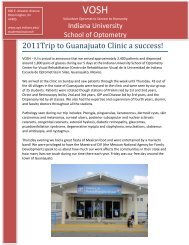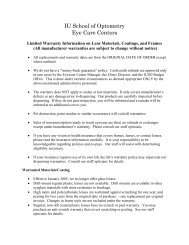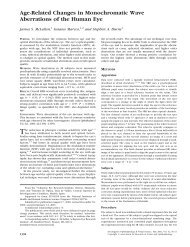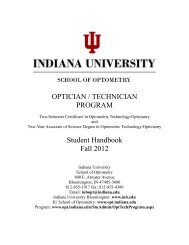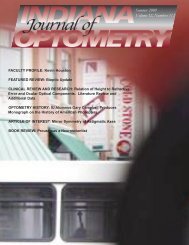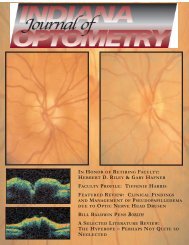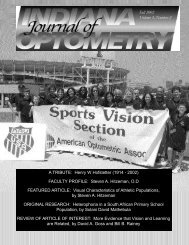Summer 2000 - Indiana University School of Optometry
Summer 2000 - Indiana University School of Optometry
Summer 2000 - Indiana University School of Optometry
Create successful ePaper yourself
Turn your PDF publications into a flip-book with our unique Google optimized e-Paper software.
allow the peripheral cornea to stretch and thus reduce<br />
central corneal curvature, LTK causes peripheral<br />
corneal shrinkage due to thermally induced shrinkage<br />
<strong>of</strong> individual collagen fibers. Thus, LTK has the<br />
opposite effect on the peripheral cornea, and therefore<br />
induces myopic shifts in the central cornea. It has<br />
been suggested and actually tested as a treatment for<br />
hyperopia (either naturally occurring or secondary to<br />
over-correction by PRK or LASIK), but it is still in the<br />
investigational stage and has not received FDA<br />
approval. There are major concerns about its ability to<br />
produce a stable refractive change since large<br />
regressions occur. Also, unlike photoablative<br />
techniques which calculate the desired tissue to be<br />
removed, LTK must rely on empirically determined<br />
nomograms. Predictability with this approach has not<br />
been established and dosimetry studies continue to<br />
examine the impact <strong>of</strong> wavelength, temperature,<br />
penetration <strong>of</strong> the radiation, beam pr<strong>of</strong>ile, and spatial<br />
pattern and duration <strong>of</strong> radiation. There is also<br />
concern that the thermal effects cannot be confined to<br />
the stroma, and damage to the epithelium and<br />
endothelium may occur.<br />
Surgical Implants<br />
In addition to the methods just described in which<br />
the cornea is reshaped by removing tissue or<br />
reshaping the cornea, two new surgical approaches<br />
are being developed that insert foreign bodies into the<br />
eye. The first inserts a ring deep into the peripheral<br />
corneal stroma and the second involves implanting an<br />
intraocular lens (IOL) into a phakic ametropic eye.<br />
1. Intrastromal Corneal Rings<br />
Just as RK and LTK change the curvature <strong>of</strong> the<br />
central cornea by changing the structure <strong>of</strong> the<br />
peripheral cornea, intrastromal corneal rings (ICR) or<br />
intrastromal corneal ring segments (ICRS) are inserted<br />
into the peripheral cornea to treat myopia. The ring or<br />
ring segments are inserted through a small incision<br />
and threaded circumferentially into the deep stromal<br />
lamellae. The structural changes that are produced<br />
translate into curvature changes in the central cornea.<br />
Inserting PMMA annular rings into the deep stromal<br />
lamellae <strong>of</strong> the corneal periphery changes the already<br />
prolate elliptical cornea into an even more prolate<br />
cornea, reducing the overall corneal curvature and<br />
thus producing a hyperopic shift. Studies indicate that<br />
myopia <strong>of</strong> up 3 or 4 diopters can be treated with this<br />
method. The biggest advantage <strong>of</strong> this approach is<br />
that, unlike PRK, RK or LASIK, it is largely reversible<br />
by simply removing the ring (segments). Thicker rings<br />
(0.45 mm diameter) introduce large changes and thus<br />
can correct for more myopia while thinner rings (0.25<br />
mm) are used to correct lower levels <strong>of</strong> myopia.<br />
BSCVAs seem to remain high and thus the method<br />
must not introduce large amounts <strong>of</strong> aberrations or<br />
turbidity in the central cornea. There is some concern<br />
that significant refractive instability exists with this<br />
method including diurnal variations. Peripheral<br />
corneal haze, small lamellae deposits adjacent to the<br />
ring, deep stromal neovascularization, and pannus are<br />
also associated with the ring insertions. Currently the<br />
FDA has approved one ICR (Keravision’s Intacs).<br />
2. Phakic Intraocular Lenses<br />
Unlike the previous methods, which all required<br />
the development <strong>of</strong> new technology, IOL implantation<br />
has a long and successful history as a treatment for<br />
cataract. The major difference with phakic IOL<br />
implantation is that the natural lens is left in place.<br />
The general principle <strong>of</strong> using an IOL to correct for<br />
ametropia has <strong>of</strong> course been part <strong>of</strong> the typical<br />
cataract lens replacement regime for many years. By<br />
manipulating the curvature, refractive index and<br />
thickness <strong>of</strong> an IOL, significant refractive errors can be<br />
corrected by the cataract surgery.<br />
A phakic IOL (PIOL) is placed in either the anterior<br />
or the posterior chamber and anchored in a similar<br />
way to that <strong>of</strong> traditional IOLs. PIOLs are made <strong>of</strong><br />
flexible materials such a silicone and hydrogelcollagen,<br />
and can be anchored with nylon haptics or<br />
other mechanical anchors. The anterior chamber<br />
PIOLs typically anchor in the angle between the<br />
cornea and iris while posterior chamber PIOLs anchor<br />
around the zonules. One beneficial effect <strong>of</strong><br />
transferring the myopic correction from the spectacle<br />
to the iris plane is that there will be significant image<br />
magnification which is responsible for the observed<br />
improvements in VA after this procedure.<br />
The primary concerns with phakic IOLs stem from<br />
the intrusive nature <strong>of</strong> the surgery in an eye that does<br />
not need to be opened and the introduction <strong>of</strong> a<br />
foreign body into the eye. For example, the<br />
acceptably low levels <strong>of</strong> complications associated with<br />
cataract surgery may be unacceptably high for phakic<br />
IOL refractive surgeries. Also, recurring problems with<br />
lenticular and corneal physiology, the development <strong>of</strong><br />
cataracts, and reduced endothelial cell counts cast<br />
doubt on the acceptability <strong>of</strong> this approach for routine<br />
refractive surgery.<br />
The efficacy <strong>of</strong> this approach hinges on the<br />
application <strong>of</strong> thick lens optics and accurate biometric<br />
data on the eye. There is still some uncertainty in<br />
calculating the required PIOL power and therefore the<br />
post surgical refractions are not very accurate with<br />
residual errors <strong>of</strong> up to 6 diopters. These inaccuracies<br />
are, <strong>of</strong> course, affected by the precise position <strong>of</strong> the<br />
lens in the eye, and this can vary significantly from eye<br />
to eye.<br />
There are two primary safety issues that continue<br />
to compromise this approach. First, posterior chamber<br />
..........................................................<strong>Indiana</strong> Journal <strong>of</strong> <strong>Optometry</strong> ... <strong>Summer</strong> <strong>2000</strong> ... Vol. 3, No. 1... page 11



